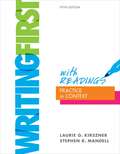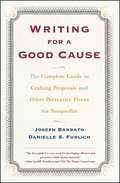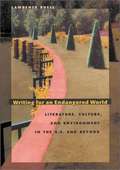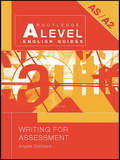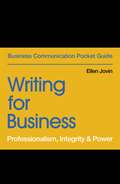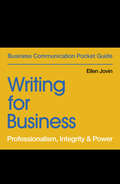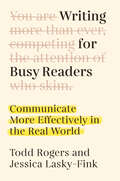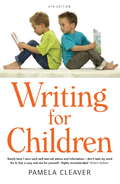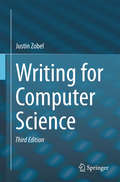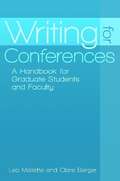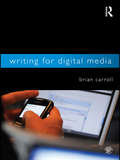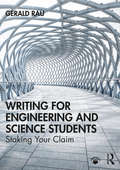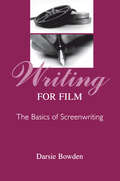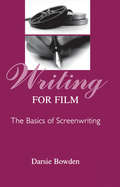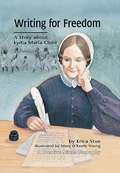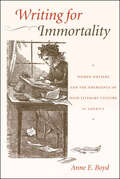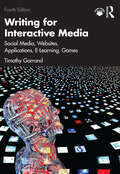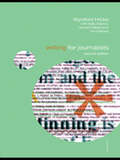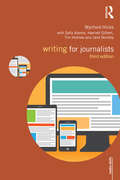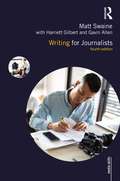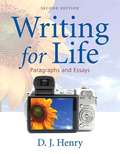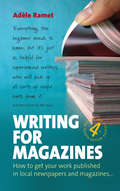- Table View
- List View
Writing First With Readings: Practice In Context
by Laurie G. Kirszner Stephen R. MandellBest-selling authors and veteran college writing instructors Laurie Kirszner and Stephen Mandell believe that students learn to write best when they use their own writing as a starting point. In Writing First with Readings: Practice in Context, designed for the paragraph to essay course, Kirszner and Mandell take seriously the ideas and expressive abilities of developmental students, as well as their need to learn the rules of writing and grammar. Visual writing prompts that open every chapter get students writing immediately. By moving frequently between their own writing, writing models and instruction, and workbook-style mastery exercises, students get constant reinforcement of the skills they are learning. Thoughtful chapters on college success, research, and critical reading, along with high-interest essays, round out the text, making it the perfect introduction to college writing.
Writing For a Good Cause
by Joseph Barbato Danielle FurlichFilled with tips and survival skills from writers and fund-raising officers at nonprofits of all sizes, Writing for a Good Cause is the first book to explain how to use words well to win your cause the money it needs. Whether you work for a storefront social action agency or a leading university, the authors' knowledgeable, practical advice will help you: Write the perfect proposal -- from the initial research and interviews to the final product Draft, revise, and polish a "beguiling, exciting, can't-put-it-down and surely can't-turn-it-down" request for funds Create case statements and other big money materials -- also write, design, and print newsletters, and use the World Wide Web effectively Survive last-minute proposals and other crises -- with the Down-and-Dirty Proposal Kit! Writing for a Good Cause provides everything fund raisers, volunteers, staff writers, freelancers, and program directors need to know to win funds from individual, foundation, and corporate donors.
Writing for Academic Journals
by MurrayWriting for publication is a daunting and time-consuming task for many academics. And yet the pressure for academics to publish has never been greater. This book demystifies the process of writing academic papers, showing readers what good papers look like and how they can be written. Offering a research-informed understanding of the contemporary challenges of writing for publication, this book gives practical advice for overcoming common obstacles such as finding a topic, targeting journals, and finding the time to write. The author offers a range of helpful writing strategies, making this an invaluable handbook for academics at all stages of their career, from doctoral students to early career researchers and even experienced academics. The third edition has been comprehensively updated to reflect the changing landscape of academic writing, including the most recent research and theory on writing across the disciplines. Drawing on her extensive experience of running writing workshops and working closely with academics on developing writing, Rowena Murray offers practical and tested strategies for good academic writing. New to the third edition: Advice on how to use social media to promote your publications More examples from different disciplines and journals More advice on how to tackle writer's block Extended end-of-chapter checklists New evidence that these strategies really work!
Writing For an Endangered World: Literature, Culture, and Environment in the U. S. and Beyond
by Lawrence BuellThe environmental imagination does not stop short at the edge of the woods. Nor should our understanding of it, as Lawrence Buell makes clear in this book that aims to reshape the field of literature and environmental studies. Emphasizing the influence of the physical environment on individual and collective perception, his book thus provides the theoretical underpinnings for ecocriticism.
Writing for Assessment (Routledge A Level English Guides)
by Angela GoddardThis text helps students to develop the writing skills they need to succeed in AS and A2 level English; offers a step-by-step guide to approaching writing tasks and structuring a response; looks at a range of writing tasks, from argumentative essays to data-based investigations; provides Personal Audit Sheets (PASS) to help students assess their own writing skills and make practical steps to develop them; can be used as preparation for both coursework and exams.Written by an experienced teacher, author and AS and A2 level examiner, Writing for Assessment is an essential resource for all students of AS and A2 level English Language, English Literature, and English Language and Literature.
Writing for Broadcast Journalists (Media Skills)
by Rick Thompson'This is a superb book which combines the rare mixture of high quality information with humour. The style of writing engages the reader from the introduction and the experience and insight of the author occasionally makes it difficult to put down, a rare feature of a textbook. I would unreservedly recommend this book not only to those studying journalism but to students of language and all who use the spoken and written word as the ‘materials’ of their work.' Barry Turner, Nottingham Trent University 'Rick Thompson's guidance manual is packed with advice to would-be writers for this medium. He's someone with years of experience at the top level of the national and international profession, and he's smack up to date with his references. The book is aimed at journalists, but anyone with a serious interest in developing their literacy will learn a lot about professional writing skills from what he has to say.' Roy Johnson, www.mantex.co.uk Writing for Broadcast Journalists guides readers through the significant differences between the written and the spoken versions of journalistic English. It will help broadcast journalists at every stage of their careers to avoid such pitfalls as the use of newspaper-English, common linguistic errors, and Americanised phrases, and gives practical advice on accurate terminology and pronunciation, while encouraging writers to capture the immediacy of the spoken word in their scripts. Writing for Broadcast Journalists includes: practical tips on how to avoid ‘journalese’, clichés and jargon guidance on tailoring your writing style to suit a particular audience advice on converting agency copy into spoken English writing to television pictures examples of scripts from some of the best in the business an appendix of ‘dangerous’ words and phrases to be avoided in scripts.
Writing for Business: Professionalism, Integrity & Power
by Ellen JovinBuild essential skills and write with confidence at work! Immediately practical guide to better business writing designed to help you develop a clear, direct, natural communication style that supports rather than obscures what you want to say. Writing for Business covers writing principles that are relevant for a wide range of business documents, including email, letters, memos, reports, proposals, and more, while also offering editing tips to ensure you come across as professional and polished. The book features examples and tips straight from the workplace.
Writing for Business: Professionalism, Integrity & Power (Business Communication Pocket Guides)
by Ellen JovinBuild essential skills and write with confidence at work! Immediately practical guide to better business writing designed to help you develop a clear, direct, natural communication style that supports rather than obscures what you want to say. It covers writing principles relevant for a wide range of business documents, including email, letters, memos, reports, proposals, and more, while also offering editing tips to ensure you come across as professional and polished. Packed with examples and tips straight from the workplace.
Writing for Busy Readers: Communicate More Effectively in the Real World
by Todd Rogers Jessica Lasky-FinkWriting well is for school. Writing effectively is for life. Todd Rogers and Jessica Lasky-Fink offer the most valuable practical writing advice today. Building on their own research in behavioral science, they outline cognitive facts about how people actually read and distill them into six principles that will transform the power of your writing: Less is moreMake reading easyDesign for easy navigationUse enough formatting, but no moreTell readers why they should careMake responding easyIncluding many real-world examples, a checklist and other tools, this guide will make you a more successful and productive communicator. Rogers and Lasky-Fink bring Strunk and White&’s core ideas into the twenty-first century&’s attention marketplace. When the influential guides to writing prose were written, the internet hadn&’t been invented. Now, the average American adult is inundated with digital messages each day. With all this correspondence, capturing a busy reader&’s attention is more challenging than ever. This is how to do it.
Writing For Children, 4th Edition
by Pamela CleaverThis new edition combines Pamela Cleaver's bestselling Writing a Children's Book with her Ideas for Children's Writers. In it you will learn about plotting and planning, beginnings, middles and endings, how to research and how to revise and how to find a publisher. There are: * Lists of attributes to help you create interesting and believable characters * Lists of plots and themes * Genres - what's hot and what's not * Locations and how much description to use * List of do's and don'ts regarding submitting manuscripts * Symbols for correcting your proofs * Tips on how to publicise your book. There is no one right way to write a children's book but if you are armed with a knowledge of certain techniques that have worked for other writers you will be more likely to succeed.Contents: Acknowledgements; Introduction; 1. Limbering Up; 2. Plotting; 3. Story People: the Characters in Your Book; 4. Genres; 5. Where and When?; 6. Starting the Story; 7. Telling the Tale; 8. Writing for the Younger Set; 9. Happy Ever After?; 10. Research and Revision; 11. Writing a Non-Fiction Book; 12. Getting Published; 13. If Your Book is Accepted; 14. If Your Book is Rejected; Useful Information for Writing Children's Book; Index.
Writing for Computer Science
by Justin ZobelAll researchers need to write or speak about their work, and to have research that is worth presenting. Based on the author's decades of experience as a researcher and advisor, this third edition provides detailed guidance on writing and presentations and a comprehensive introduction to research methods, the how-to of being a successful scientist. Topics include: · Development of ideas into research questions; · How to find, read, evaluate and referee other research; · Design and evaluation of experiments and appropriate use of statistics; · Ethics, the principles of science and examples of science gone wrong. Much of the book is a step-by-step guide to effective communication, with advice on: · Writing style and editing; · Figures, graphs and tables; · Mathematics and algorithms; · Literature reviews and referees' reports; · Structuring of arguments and results into papers and theses; · Writing of other professional documents; · Presentation of talks and posters. Written in an accessible style and including handy checklists and exercises, Writing for Computer Science is not only an introduction to the doing and describing of research, but is a valuable reference for working scientists in the computing and mathematical sciences.
Writing for Conferences: A Handbook for Graduate Students and Faculty
by Leo A. Mallette Clare BergerThe authors present a practical text for graduate students and faculty, as well as professionals working in areas outside academia--businesses, government entities, and nonprofit organizations--that encourage employees to publish at conferences. Organized into sections corresponding to the timeline of a conference paper, the text covers reasons for choosing to publish at conferences versus in journals or magazines, what it will cost, and publishing statistics; steps for selecting the right conference, including finding upcoming conferences, reading a call for papers, and the timeline for submitting a paper to a conference; deciding on solo authorship versus multiple authorship, finding co-authors, and the abstract submission process; writing a paper in a scholarly way; preparing for and giving the conference presentation; social interaction and networking at the conference; and how to be session chair. The material is illustrated throughout with case studies, examples, and vignettes from the literature and the authors' experiences.
Writing for Digital Media
by Brian CarrollWriting for Digital Media teaches students how to write effectively for online audiences--whether they are crafting a story for the website of a daily newspaper or a personal blog. The lessons and exercises in each chapter help students build a solid understanding of the ways that the Internet has introduced new opportunities for dynamic storytelling as digital media have blurred roles of media producer, consumer, publisher and reader. Using the tools and strategies discussed in this book, students are able to use their insights into new media audiences to produce better content for digital formats and environments. Fundamentally, this book is about good writing--clear, precise, accurate, filled with energy and voice, and aimed directly at an audience. Writing for Digital Media also addresses all of the graphical, multimedia, hypertextual and interactive elements that come into play when writing for digital platforms. Learning how to achieve balance and a careful, deliberate blend of these elements is the other primary goal of this text. Writing for Digital Media teaches students not only how to create content as writers, but also how to think critically as a site manager or content developer might about issues such as graphic design, site architecture, and editorial consistency. By teaching these new skill sets alongside writing fundamentals, this book transforms students from writers who are simply able to post their stories online into engaging multimedia, digital storytellers. For additional resources and exercises, visit the Companion Website for Writing for Digital Media at: www.routledge.com/textbooks/9780415992015.
Writing for Engineering and Science Students: Staking Your Claim
by Gerald RauWriting for Engineering and Science Students is a clear and practical guide for anyone undertaking either academic or technical writing. Drawing on the author’s extensive experience of teaching students from different fields and cultures, and designed to be accessible to both international students and native speakers of English, this book: Employs analyses of hundreds of articles from engineering and science journals to explore all the distinctive characteristics of a research paper, including organization, length and naming of sections, and location and purpose of citations and graphics; Guides the student through university-level writing and beyond, covering lab reports, research proposals, dissertations, poster presentations, industry reports, emails, and job applications; Explains what to consider before and after undertaking academic or technical writing, including focusing on differences between genres in goal, audience, and criteria for acceptance and rewriting; Features tasks, hints, and tips for teachers and students at the end of each chapter, as well as accompanying eResources offering additional exercises and answer keys. With metaphors and anecdotes from the author’s personal experience, as well as quotes from famous writers to make the text engaging and accessible, this book is essential reading for all students of science and engineering who are taking a course in writing or seeking a resource to aid their writing assignments.
Writing for Film: The Basics of Screenwriting
by Darsie BowdenIn this introduction to screenwriting, author Darsie Bowden provides sage, real-world advice and instruction on the process of writing film screenplays. This text will help budding screenwriters to structure their dramas, refine their characterizations, and craft their language, while also introducing them to the appropriate screenplay formats. It covers the complexities of writing for the screen and points out the contradictions to expect if readers pursue this work as a career. In addition to covering the elements of the dramatic film screenplay, Bowden discusses writing for such "alternative" markets as documentaries, independent films, experimental films, and other non-Hollywood options. Features of the text include:guidelines for working as a screenwriter;applications and exercises to enhance skills;suggested readings for further development; anda comprehensive list of resources for screenwriting.Successful writing for film lies in being able to heighten one's perceptive abilities about the world and to communicate those perceptions in a cinematic way. In this text, Bowden introduces readers to an approach to screenwriting that will help them see the world in a different way and write about it using different genres and media. This most valuable skill prepares readers for the range of possibilities they will encounter on the path to successful screenwriting.
Writing for Film: The Basics of Screenwriting
by Darsie BowdenIn this introduction to screenwriting, author Darsie Bowden provides sage, real-world advice and instruction on the process of writing film screenplays. This text will help budding screenwriters to structure their dramas, refine their characterizations, and craft their language, while also introducing them to the appropriate screenplay formats. It covers the complexities of writing for the screen and points out the contradictions to expect if readers pursue this work as a career. In addition to covering the elements of the dramatic film screenplay, Bowden discusses writing for such "alternative" markets as documentaries, independent films, experimental films, and other non-Hollywood options. Features of the text include:guidelines for working as a screenwriter;applications and exercises to enhance skills;suggested readings for further development; anda comprehensive list of resources for screenwriting.Successful writing for film lies in being able to heighten one's perceptive abilities about the world and to communicate those perceptions in a cinematic way. In this text, Bowden introduces readers to an approach to screenwriting that will help them see the world in a different way and write about it using different genres and media. This most valuable skill prepares readers for the range of possibilities they will encounter on the path to successful screenwriting.
Writing for Freedom: A Story about Lydia Maria Child
by Erica StuxA biography of the woman who risked her success in the male-dominated literary world of nineteenth-century America to become a passionate advocate for the abolition of slavery.
Writing for Immortality: Women and the Emergence of High Literary Culture in America
by Anne E. BoydBefore the Civil War, American writers such as Catharine Maria Sedgwick and Harriet Beecher Stowe had established authorship as a respectable profession for women. But though they had written some of the most popular and influential novels of the century, they accepted the taboo against female writers, regarding themselves as educators and businesswomen. During and after the Civil War, some women writers began to challenge this view, seeing themselves as artists writing for themselves and for posterity.Writing for Immortality studies the lives and works of four prominent members of the first generation of American women who strived for recognition as serious literary artists: Louisa May Alcott, Elizabeth Stuart Phelps, Elizabeth Stoddard, and Constance Fenimore Woolson. Combining literary criticism and cultural history, Anne E. Boyd examines how these authors negotiated the masculine connotation of "artist," imagining a space for themselves in the literary pantheon. Redrawing the boundaries between male and female literary spheres, and between American and British literary traditions, Boyd shows how these writers rejected the didacticism of the previous generation of women writers and instead drew their inspiration from the most prominent "literary" writers of their day: Emerson, James, Barrett Browning, and Eliot.Placing the works and experiences of Alcott, Phelps, Stoddard, and Woolson within contemporary discussions about "genius" and the "American artist," Boyd reaches a sobering conclusion. Although these women were encouraged by the democratic ideals implicit in such concepts, they were equally discouraged by lingering prejudices about their applicability to women.
Writing for Interactive Media: Social Media, Websites, Applications, e-Learning, Games
by Timothy GarrandThis thoroughly revised fourth edition teaches students and professionals how to create interactive content for all types of new media and become successful writers or designers in a variety of fields. This comprehensive guide is grounded in the core principles and skills of interactive media writing, in which writers create text and structure content to guide users through interactive products such as websites or software. The book examines case studies on interactive formats including complex informational websites, computer games, e-learning courses, training programs, and immersive exhibits. These case studies assess real-world products and documentation used by professional writers such as scripts, outlines, screenshots, and flowcharts. The book also provides practical advice on how to use interactive media writing skills to advance careers in the social media, technical, instructional communication, and creative media fields. This edition includes new chapters on UX Writing and Content Design, Social Media Writing, and Writing for Mobile. Writing for Interactive Media prepares students for the writing challenges of today’s technology and media. It can be used as a core textbook for courses in UX Writing, Writing for Digital Media, and Technical and Professional Communication and is a valuable resource for writing professionals at all levels. Supplemental resources include a sample syllabus, class assignments, student exercises, scripts, outlines, flowcharts, and other interactive writing samples. They are available online at www.routledge.com/9781032554242
Writing for Journalists (Media Skills)
by Tim Holmes Sally Adams Harriett Gilbert Wynford HicksPraise for the first edition: 'There are books that are badly written, books that are well written and books that you wish you'd written. This is one of the latter. Hicks and his co-writers produce a book that is a joy to read and is packed full of helpful advice.' - Chris Frost, Journalist 'You don't have to be a journalist to read this book. Anyone with an interest in improving their writing skills and developing a sense of good style will find it useful Wynford Hicks takes a no-nonsense, sleeves rolled up approach to writing which has no time for preciousness.' - Roy Johnson, Mantex'Writing for Journalists neatly fills a gap in the market for a no-nonsense book for trainees written by trainers who genuinely understand the industry and who have moved with the times.' - Sharon Wheeler, Journalism Studies Writing for Journalists is about the craft of journalistic writing: how to put one word after another so that the reader gets the message - or the joke - goes on reading and comes back for more. It is a practical guide for all those who write for newspapers, periodicals and websites, whether students, trainees or professionals. This revised and updated edition introduces the reader to the essentials of good writing. Based on critical analysis of news stories, features and reviews from daily and weekly papers, consumer magazines, specialist trade journals and a variety of websites, Writing for Journalists includes: advice on how to start writing and how to improve and develop your style how to write a news story which is informative, concise and readable tips on feature writing from researching profiles to writing product round-ups how to structure and write reviews a new chapter on writing online copy.
Writing for Journalists (Media Skills)
by Tim Holmes Adams Sally Harriett Gilbert Wynford Hicks Jane BentleyThe new edition of Writing for Journalists focuses on the key issue for writers working across all forms of media today: how to produce clear, engaging and illuminating copy that will keep the reader hooked from start to finish. Written by skilled specialist contributors and drawing on a broad range of examples to illustrate the best professional practice, this edition includes: chapters on how to write news, features and reviews whatever the format used for delivery expanded chapters on writing for digital publication in both shortform and longform top tips on writing columns and blogs from leading professionals an exploration of the importance of style and its impact on great journalistic writing an extensive glossary of terms used in journalism and suggestions for further reading This is an essential guide to good writing for all practising journalists and students of journalism.
Writing for Journalists (Media Skills)
by Matt Swaine Harriett Gilbert Gavin AllenThoroughly revised and updated, the fourth edition of Writing for Journalists focuses on the craft of journalistic writing, offering invaluable insight on how to hook readers and keep them to the end of your article. The book offers a systematic approach to news and feature writing that starts with the basics and builds to more complex and longer pieces. The authors give the reader the tools they need to deliver engaging and authoritative writing that works across print and digital. Drawing on professional insight from writers across the industry, the book guides readers through the essential elements needed to write powerful and effective news stories, from hard news pieces to features on business, science, travel and entertainment reviews. New to this edition are hands-on writing exercises accompanying each chapter to help reinforce key points; chapters on how to build a professional profile, pitch stories and get commissioned; and a section on online writing, SEO, analytics and writing for social media. This is an essential guide for all journalism students and early-career journalists. It also has much to offer established journalists looking to develop their writing and lead editorial teams.
Writing For Life (Second Edition)
by D. J. HenryD. J. Henry wrote Writing for Life from the ground up for today's college student. The ground-breaking approach of combining instruction and visual tools makes writing, reading and thinking processes visible, and shows the processes rather than just telling students about them. Highly graphic layouts and unique visual pedagogy empower students to transfer the learning strategies they already use in interpreting the visual world to the task of writing.
Writing for Magazines: How to get your work published in local newspapers and magazines
by Adèle RametWritten by an experienced author, this practical book shows you how to produce manuscripts to fit a specific slot, advises you on how to adapt your style to suit different markets, and how to utilise research material to write facts and fiction effectively.Contents: 1. Mixing fact and fiction; 2. Constructing an article; 3. Getting articles into print; 4. Researching and filing systems; 5. Rewriting for different markets; 6. Writing short stories; 7. Caring for your characters; 8. Finding the right format; 9. Creating a Twist in the Tale; 10. Signposting; 11. Twisting With Little Old Ladies; 12. Fitting a Specific Plot; 13. Working as a Freelance; 14. Marketing Your Manuscript; 15. Keeping Records; Solutions to exercises; Glossary; Useful addresses; Further reading; Index.
Writing For Magazines (4th Edition): How to get your work published in local newspapers and magazines
by Adèle RametWritten by an experienced author, this practical book shows you how to produce manuscripts to fit a specific slot, advises you on how to adapt your style to suit different markets, and how to utilise research material to write facts and fiction effectively.Contents: 1. Mixing fact and fiction; 2. Constructing an article; 3. Getting articles into print; 4. Researching and filing systems; 5. Rewriting for different markets; 6. Writing short stories; 7. Caring for your characters; 8. Finding the right format; 9. Creating a Twist in the Tale; 10. Signposting; 11. Twisting With Little Old Ladies; 12. Fitting a Specific Plot; 13. Working as a Freelance; 14. Marketing Your Manuscript; 15. Keeping Records; Solutions to exercises; Glossary; Useful addresses; Further reading; Index.
